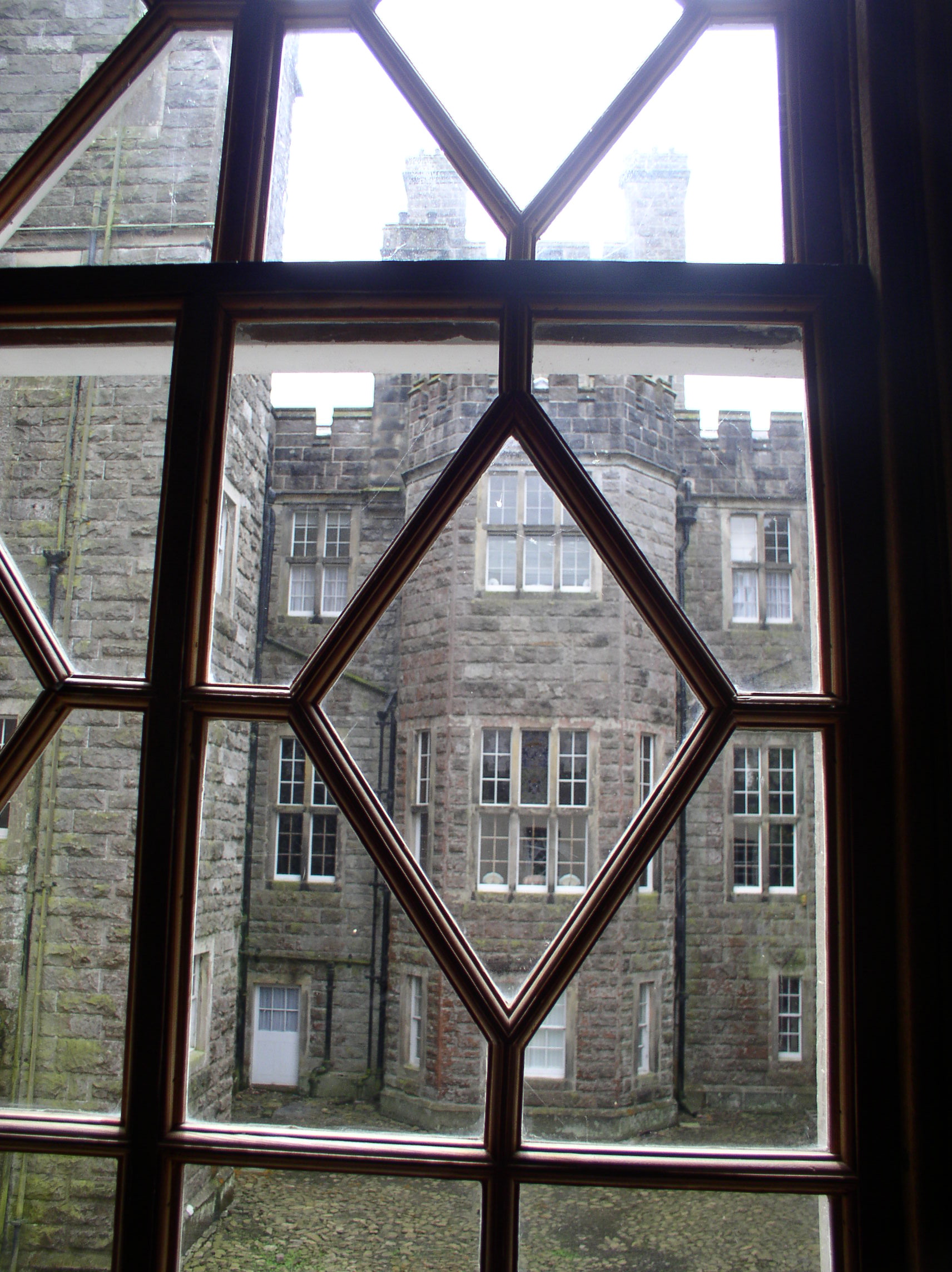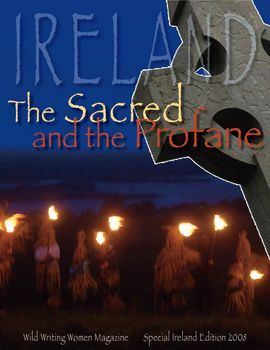
Guess who’d been sleeping in one of the Wild Writing Women’s beds? No, not Goldilocks… .
Our hosts at Crom Castle in Northern Ireland, Lord and Lady Erne, just happen to be buddies with the Prince of Wales and the Duchess of Cromwell. Charles and Camilla slept in one of the sumptuous four-poster beds just a few months before the we arrived for our week-long stay. No doubt, the couple enjoyed their getaway in the Buff Room, a particularly elegant guest accommodation with fireplace and all. Odd name, though.
There is a secret door in the wall that separates the main castle from the West Wing where guests stay, which was left open for the Royals so they could just pop on over to the Lord’s for drinks or tea. We, on the other hand, did not know about the secret entrance until several days after we had settled in, when Harry (Lord Erne’s first name) called and invited us to visit him and Anna, his wife, for drinks. We gussied up and waited where he told us to—in the cramped stairwell on the second floor of the West Wing. Odd, again.
A creaking sound of wood scuffing against stiff carpet drew our attention to the wall—it was moving! Just a crack at first, but then the door swung open and there stood the Lord and Lady of the manor with smiles and handshakes, ushering us into their private castle. It was a world of grand, dark wood staircases, monolithic family portraits, and champagne flutes filled with Prosecco (I was disappointed it wasn’t French bubbly).
Crom Estate, in County Fermanagh in Northern Ireland, has been the residence and the historic seat of the Earls of Erne for over 350 years. Our host was the Sixth Earl of Erne.
In the stunningly large living room with views over the lawns to the lake, open-armed oaks and herds of fallow deer created a moving diorama, and framed photos of queens and other familiar faces dotted the interior landscape. (People Magazine is my reference point for the celebrity who’s who.) On the Steinway piano, polished to an ebony gleam, were several photographs of a divinely elegant young woman—think Jackie O. They were all Lady Erne, fresh from Sweden when she worked at the Ford Modeling Agency 20 years before in Manhattan. She was one of their top models before becoming a Lady in a castle. Need I say, a fairytale come true?
Lady Erne engaged all of us in stories of travel and writing. Her husband published a children’s book about a donkey and we exchanged autographed copies of our various books including Wild Writing Women: Stories of World Travel. They were intrigued with Carla’s motorcycle misadventures in her book, American Borders. They read it to each other after retiring that night, and had many questions the next morning, when the secret door opened yet again. Lady Erne said they were “all atwitter” over a scene in the first chapter in which Carla describes frolicking naked through the woods in the rain in Southern France with a newfound lover. “Just riveting!” gushed Harry to me, his eyebrows rising and falling rapidly. He had confused me with Carla and thought I was the one running around in the buff.
So how did we end up in this glorious castle in Northern Ireland? Maureen Wheeler, co-founder of Lonely Planet Travel Guides and an honorary member of our posse, was born and raised in Belfast. She knew of Crom, and suggested we hold our bi-annual Wild Writing Women gathering at the castle.
Invited to stay at a castle? Who could say no? The idea seemed just right.
From Dublin, we had driven a few hours and crossed into Northern Ireland, all the while fighting the tendency to veer over to the right side of the road. Screams from the other Wild Writing Women sitting in the backseat were quite helpful in keeping Carla and me focused while driving country lanes, barely the width of a fat cow, toward our fantasy destination.
We knew we were close when the castle ramparts peaked over a rolling emerald hill. The road snaked around the hillock, and we all exhaled at once when the full monty in all its grand proportions, spires and arches, was revealed, back-dropped against a misty lough. Oh my god! echoed in unison from the women in the backseat.
For the entire week, the oh-my-god! reactions continued as we explored Crom Castle’s neo-Tudor turrets and crenellated towers stretching into the sky. You just don’t adapt that quickly to living in a castle. It’s different than a hotel, we realized. We had the entire West Wing to ourselves. Well, except for the ghost.
“Are any of the guest rooms haunted?” I asked Noel Johnston, the castle manager, when he gave us a tour on our first day of the elegant rooms. They seemed perfect quarters for spirits. He hesitated, and chuckled. “Oh, there’ve been stories…”
He led us to the Rose Room all the way at the end of the hall. Large-petaled, sherbet colored roses spilled all over the wallpaper, the bedspreads, and the curtains. High ceilings, a fireplace, oodles of porcelain objet and a bathtub you could drown in. After I dibbed the room as mine, Noel piped up, “Some folks do indeed see a lady float through these walls….”
I had my antennae out that first night, eyeing any mischievous movements or shadows crossing the walls. But not a hair rose on my arms and I slept uninterrupted. Perhaps the effect of the weighty down comforter and walls as thick as a fortress kept otherworldly intruders at bay. I slept blanketed in the history of solitude, and stillness of the Irish countryside.
Mornings began officially with the filling of the teapot, after which we would slowly meander groggy-eyed into the Victorian Conservatory to write. The immense glassed-in structure towered above us like a crystal cathedral. We’d plug in our laptops—a real juxtaposition in this setting—and write, each of us in silence, for several hours until taking a yoga stretch break.
The biggest downfall of being a writer—other than the pay scale—is sitting on our posterior far too much. We combated the sitting with a series of highly un-Victorian poses: legs spread wide, derrières to the sky, various gyrations. At one point, all the Wild Writing Women were bent over, reaching for our ankles, when I heard a shuffling sound. It was Noel, edging backward out the door. “Methought you women were writers, not gymnasts,” he said. We all laughed when he added, “Do youse do this every morning? Very interestin’! I’ll keep an eye out for youse next meetin’.”
One day, I decided I felt slightly feverish and needed to retire to my room with tea and books. It was really just an excuse to soak up the rose factor and the delight of having the castle all to myself for an entire day. The rest of the Wild Writing Women went on an excursion. I wandered the stairways in my bathrobe. I luxuriated in that tub, which was so deep that I needed to prop myself up in order to keep my book from going under. The spaciousness, the time, the solitude, the luxury—I felt like an eccentric Royal myself. Castles do that to you.
“There is no place that conjures up in my mind more Irish romance than the wide and fair domains of Crom.” John Ynyr Burges of County Tyrone wrote this in his diary when he was a guest at the castle in 1863.
Ol’ John got it right. A romantic castle within a parkland of some 1,900 acres, Crom is surrounded by the glistening waters of Lough Erne, which forms one of the longest inland waterways in Europe. The lake is dotted with a myriad of mysterious islands, many visible from the castle windows. Crichton Tower on Gad Island is a stone folly built in1847, appearing to float not far offshore and beckoning us to visit in the motorboat provided for guests staying at the castle. Grebes call from the water grasses, swans hypnotically weave their graceful dance around the edges of the island and herons break free from their tangled root perches to take flight on huge flapping wings of gunpowder blue. Crom is home to the largest heron rookery in Ireland. Truly a living postcard.
Built in the 1830s for the Third Earl of Erne, after the original castle was destroyed by fire, Crom Castle was designed by the English architect Edward Blore, best known for his work on Buckingham Palace. The suggestively haunting ruins of the original castle lie on the shore of the lake. It survived two bloody Jacobite sieges before it burned down.
Two immense yew trees, one male and one female, guard the entrance to the old castle grounds. They have formed a citadel of intertwining branches. Over eight hundred years old, they are reputed to be the oldest trees in Ireland. Legend says that it was underneath this canopy that Hugh O’Neill, Earl of Tyrone and leader of the Irish struggle against English domination, kissed his lady love goodbye in 1607 before taking a ship from Ireland into exile, never to return.
After a few days of drizzly walks, long writing sessions and teatime by the fireplace, jetlag eased and we got curious about our surroundings. Maps came out. Excursions were planned. But the leprechauns seemed to play tricks on our sense of direction. Winding country roads, mysterious turnoffs, un-posted destinations—we saw many things we never planned to see. Maybe that ghost of Noel’s had gotten into the car?
Returning from one of our misadventures, Violet, the housekeeper and mother of our guide Noel, fortified us with hearty Irish dinners. Think potatoes (the anchor of all Irish meals) along with lamb and mint sauce. Every plate included a russet.
At first, there was a collective rolling of eyes when the spuds appeared nightly on our plates…potatoes, again? Some of us were watching our carb intake. But a few days into our journey we were so enamored by the ubiquitous spud, we gave in and even started buying farl, a bread made from potatoes. We slathered the thick slices with golden butter and it became a must at every meal.
At dinner we quizzed Violet, who grew up here, as had her father’s father’s father.
Where to go? What to do? What was Prince Charles like?
While serving drinks by the fire one night before dinner, Noel let it leak that his mom, Violet, was a skilled tealeaf reader. On our last night at the castle, she quietly ushered each of us into the kitchen. So powerful were her translations of the wet, loose leaves of tea that clung to the bottom of the Spode cup that not one of us spoke of it around the hearth that night. We kept her insights and prophecies tight to our chest like cards dealt in a game of poker. No one wanted to show her hand. Reveal her future. Violet gave us each something profound to privately ponder as drizzly, mercury-hued rain streaked the leaded glass windows.
![]()

For more tales of Ireland, read The Wishing Stone and Singing in the Irish Mist.
This story has been published in Ireland: The Sacred and the Profane and Exotic Life: Travel Tales of an Adventurous Woman.
Leave a Reply